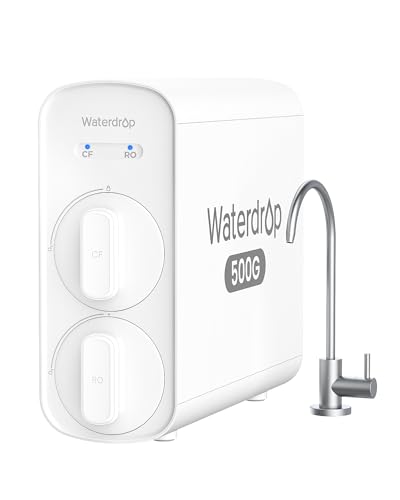Looking for a Water Filter… But Not Sure Which Type to Get?
You’re not alone — one of the most common questions homeowners ask is:
“Should I get a carbon filter or a full reverse osmosis system?”
Both options clean up your tap water, but they’re built for completely different goals. One is affordable, compact, and easy to install. The other removes nearly everything — from heavy metals to fluoride — but costs more and takes a bit more effort to set up.
In this post, we’ll break down reverse osmosis vs carbon filter systems so you can confidently decide what makes the most sense for your home, water quality, and budget.
Heads up: This post contains affiliate links. If you click and buy, we may earn a small commission — at no extra cost to you. We only recommend filters we’ve researched, tested, or would install ourselves.
Quick Comparison: Reverse Osmosis vs Carbon Filter
| Feature | Carbon Filter (e.g. 10UA) | Reverse Osmosis (e.g. G3P800) |
|---|---|---|
| Removes chlorine taste/odor | ✅ Yes | ✅ Yes |
| Removes fluoride, TDS, lead | ❌ No | ✅ Yes |
| Removes bacteria/viruses | ❌ No | ✅ Yes (with membrane) |
| Space required | Minimal | More (multi-stage unit) |
| Cost | $ | $$–$$$$ |
| Maintenance | Simple | Moderate |
| Water waste | None | Some (2:1 or 3:1 drain ratio) |
| Best for | Basic filtering, renters, small homes | High-purity water, families, long-term use |
What a Carbon Filter Actually Does
Carbon filters (like the Waterdrop 10UA) use activated carbon to trap:
- Chlorine
- Sediment
- Rust
- Odor-causing compounds
- Some PFAS/PFOA chemicals
They’re great for improving taste and clarity, and are often enough for city water in homes where water quality is decent but not perfect.
Why people choose carbon filters:
- Super easy DIY install
- No power or drain line needed
- Inexpensive upfront and long term
- Minimal space under the sink
💧 What Reverse Osmosis Removes (That Carbon Filters Can’t)
Reverse osmosis systems (like the Waterdrop G3P800 or G5P500) push water through a semi-permeable membrane that filters contaminants down to 0.0001 microns. That includes:
- Fluoride
- Lead and heavy metals
- Total dissolved solids (TDS)
- Nitrates/nitrites
- PFAS/PFOA
- Bacteria and viruses (if present)
They also include carbon pre-filters, so you get the best of both worlds.
Why people choose RO systems:
- Highest contaminant removal available for home use
- Real-time TDS monitoring (G3P800 and X12)
- Great for households with infants, elderly, or medical concerns
- Long-term water quality upgrade
What About Maintenance?
Carbon Filter (10UA):
- Replace filter every 6–12 months
- No drain line or power supply
- Installation time: ~15 minutes
- Cost: ~$40
Reverse Osmosis (G3P800, G5P500):
- Replace multiple filters (6–12 month intervals)
- Some models include smart alerts and real-time TDS
- Drain line must be flushed on install
- Installation time: ~45–60 minutes
- Cost: $270–$700+
Which One’s Best for You?
Choose a carbon filter if:
- You want better tasting water on a budget
- You live in a rental or apartment
- You’re only concerned with basic chlorine and odor
Choose reverse osmosis if:
- You want to remove fluoride, lead, and TDS
- You use your kitchen water for drinking, coffee, and cooking
- You want long-term performance and better ROI
Pro Tip: You Can Install Either One Yourself
We’ve put together a full DIY walkthrough for installing under sink water filter systems — whether you go with a 10UA carbon setup or a full RO system like the G3 or X12.
How to Install an Under Sink Water Filter →
Final Word: Both Systems Are Great — But Built for Different Homes
You’re not picking the “better” system — you’re picking the one that matches your water needs and your budget.
If you’re on a tight budget or renting:
Waterdrop 10UA Carbon Filter →
If you want cleaner water for life:
Waterdrop G3P800 or G5P500 Reverse Osmosis →
If you want top-tier performance with pH+ remineralization:
Check out the Waterdrop X12 →







